#pierre terrail
Text
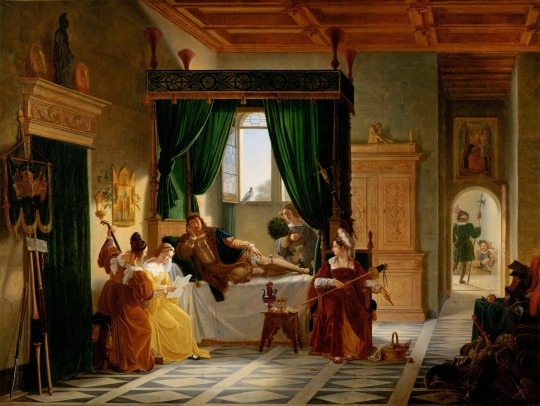
The Convalescence of Bayard | La Convalescence de Bayard
by Pierre Henri Révoil
#pierre henri révoil#art#pierre terrail#seigneur de bayard#knight#medieval#middle ages#renaissance#france#french#knights#history#europe#european#chevalier de bayard#chevalier#chivalry#knighthood#chamber#bed#sword#helmet#armour#weapons#window#bird#guards#ladies#swords#lance
35 notes
·
View notes
Text

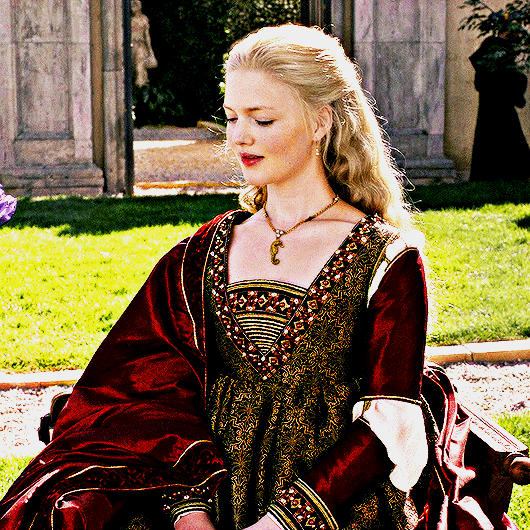
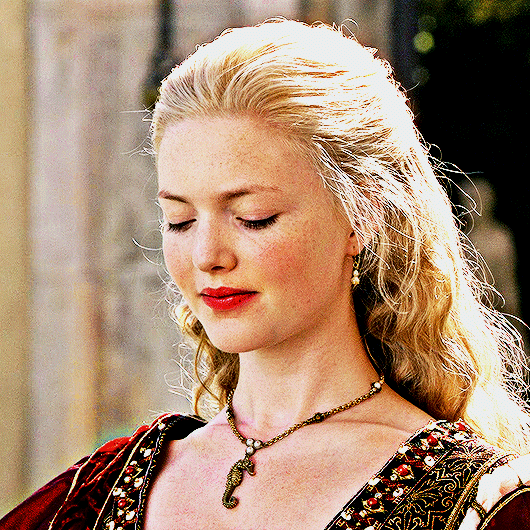
"She was beautiful, and kind, and gentle to everybody. As I was lucky enough to meet her, I can surely say she was a pearl in this world." — Pierre Terrail, the "knight without fear and beyond reproach", on Lucrezia Borgia x
#look at herrrr i know this look is overposted but i needed to try new colors you know?#lucrezia borgia#lucreziaborgiaedit#holliday grainger#hollidaygraingeredit#ladiesofcinema#femalegifsource#womendaily#femaledaily#historicalwomendaily#perioddramaedit#periodedits#tvedit#the borgias#theborgiasedit#userlenna#tuseraixa#usercleveris#userpinckertons#by jen
137 notes
·
View notes
Text
Read up on Pierre Terrail, seigneur de Bayard, a French knight from the Late Middle Ages/Early Renaissance period. He was regarded as “the knight without fear and beyond reproach” although he preferred to be simple be called “the good knight” by his contemporaries.
And he reads as THE quintessential chivalric knight during the French campaigns in Italy:
Received his investiture after the battle of Fornovo in 1595.
Helped prostitutes and the sick of plague with finances and actual aid.
On campaign, he would pay out of pocket for supplies for his forces at a time when armies just took what they wanted or needed.
Advanced with the vanguard to a battle and took to the rearguard during a retreat, he was always where the fighting was fiercest.
Ordered his men to put out fires in Italian villages, and posted sentries around churches and monasteries to prevent looting and violence upon the occupants.
During a duel with a Spanish knight, famed for being a giant man of giant strength, Pierre (while he was suffering from malaria at the time) not only defeated the Spaniard, but when his fellows tried to celebrate his victory, Pierre ordered them to silence since he did not want death celebrated.
At the battle of Garigliano, with the French army in retreat against a combined Spanish-Italian force, Pierre held the main bridge crossing alone against 300 to 400 Spaniards before being pulled back by a friend.
Honestly, the list just goes on and on for the exploits of this man, who impressed French, Italian, Spanish, German and English alike.
8 notes
·
View notes
Text
Rocambole : l’héritage mystérieux, de Pierre Alexis de Ponson du Terrail
J’ai découvert avec un grand plaisir ce classique du feuilleton du dix-neuvième siècle grâce à Voolume. J’apprécie beaucoup leur démarche qui redonne vie à des classiques oubliés du polar grâce à leurs enregistrements audio de grande qualité. Ce premier épisode de la saga est divisé en deux parties que j’ai enchaînées, j’étais trop frustrée de […]Rocambole : l’héritage mystérieux, de Pierre…

View On WordPress
0 notes
Text
Sixième guerre d’Italie - Au cours d’un bivouac, l’arrière-garde française fut attaquée par les troupes impériales de Charles Quint. Alors qu’il repoussait avec vaillance la cavalerie ennemie, Bayard fut victime d’un tir d’arquebuse qui lui traversa le flanc et toucha la colonne vertébrale. À ses compagnons qui voulaient l’emmener dans une fuite éperdue, il leur dit : « Je n'ai jamais tourné le dos devant l'ennemi, je ne veux pas commencer à la fin de ma vie ».
Fait prisonnier, il fut allongé au pied d’un arbre. Les yeux mi-clos, la tête inclinée sur son épaule et la main agrippée à son épée, il sombra peu à peu dans l’inconscience, laissant son esprit égrainer les images d’une vie mise au service de trois souverains (Charles VIII, Louis XII et François 1er). Des images où s’entremêlaient : son duel d’honneur gagné face au célèbre chef espagnol don Alonzo de Soto Mayor qu’il blessa à mort ; son action à Garigliano où il arrêta seul une cavalerie de près de 200 chevaux empêtrés sur un pont trop étroit pour les recevoir ; ses blessures profondes à Brescia et Pavie ; sa contribution aux victoires d’Agnadel, Mézières, Marignan ; son séjour dans les geôles anglaises après sa capture à Guinegatte dont la rançon fut payée par Louis XII...
Mais une ombre pesante survola son visage. Au son de sa voix, il reconnut le traître Charles de Bourbon qui avait déserté les rangs français pour rejoindre Charles Quint. L’ancien connétable qui eut connaissance de son état était venu le saluer pour lui témoigner sa compassion.
Bayard entrouvrit légèrement les yeux pour fixer une dernière fois son ancien compagnon de batailles et lui murmura :
« Monsieur, il n’est point besoin d’avoir pitié de moi, car je meurs en homme de bien. Mais moi j’ai pitié de vous, de vous voir renier votre roi, votre patrie et votre serment ».
Ce furent ses dernières paroles et Pierre du Terrail, seigneur de Bayard s’éteignit le 30 avril 1524, à l’âge de quarante-neuf ans, en bordure de la Sésia, près de Romagnano en Italie. Sa bravoure et sa noblesse d’âme lui valurent de porter ce fier surnom de Chevalier sans Peur et sans Reproche.
1 note
·
View note
Text
Dec 29 1918
New-York Tribune December 29 1918
Eagle Hut, Bryant Park - Photo by Paul Thompson
Looking into the future
The man on the poster is a late Medieval French knight, Pierre Terrail, seigneur de Bayard (or the Knight of Bayard). The writing below is a shortened version of a famous saying about him “sans peur et sans reproche”, meaning without fear and beyond reproach.
Flag looks to be similar to the battle flag that was popular in the French military of the Ancien Régime before the Revolution.
War Flag of the Ancien Régime

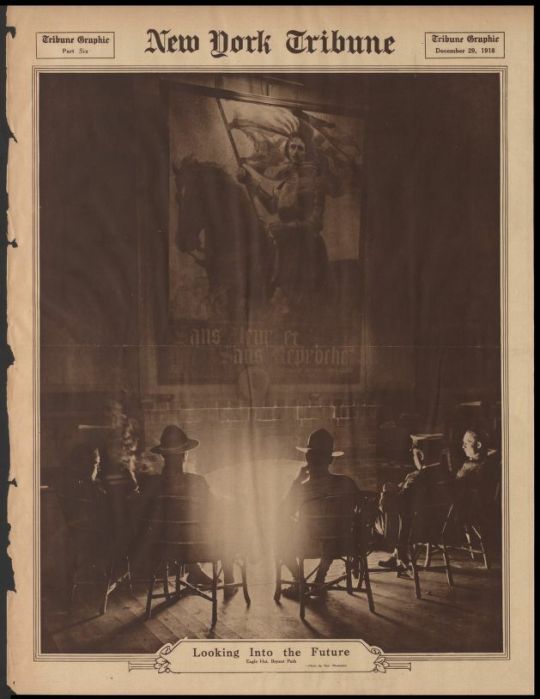
17 notes
·
View notes
Photo
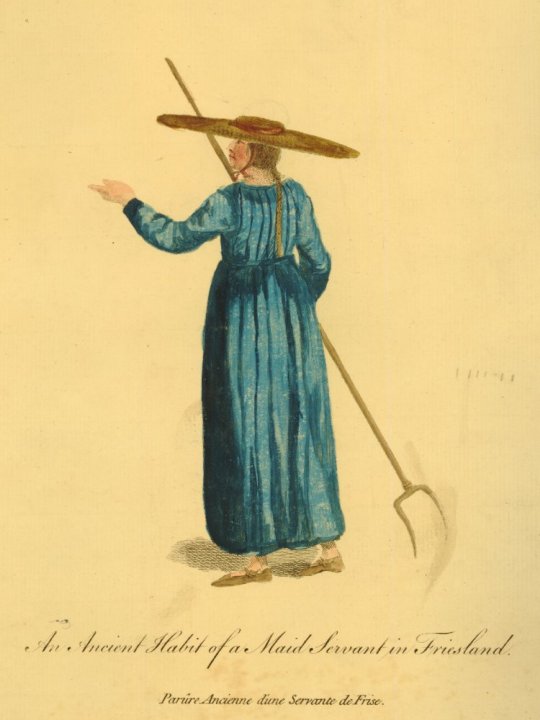
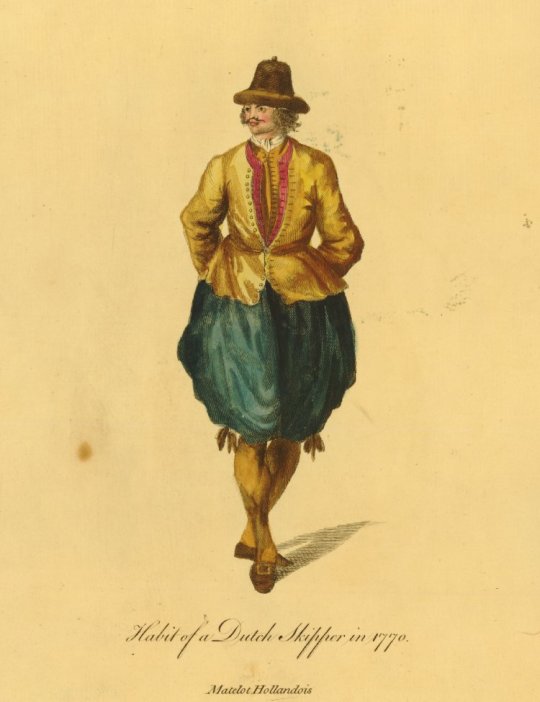

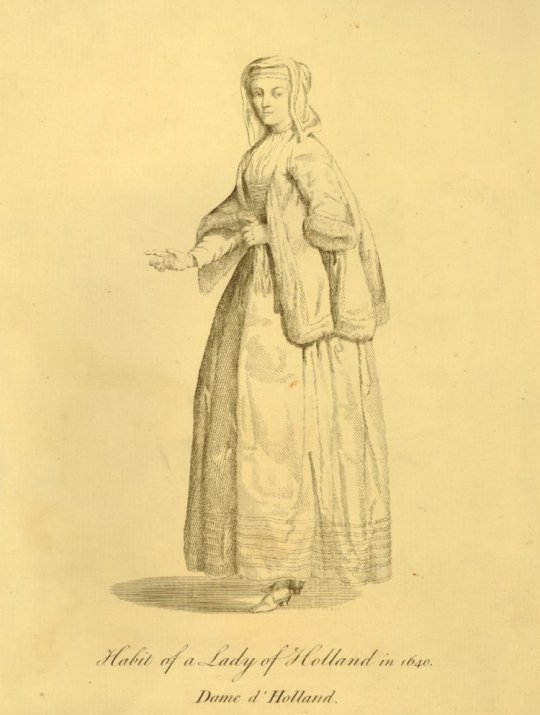

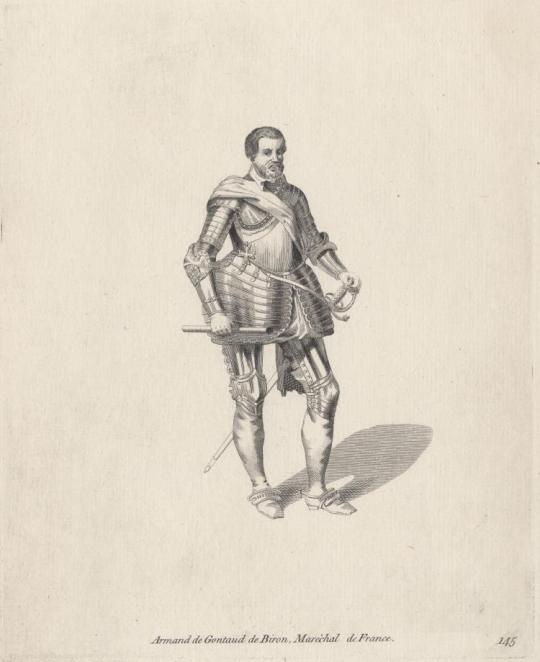
A Collection of the Dresses of Different Nations (published in England, c. 1757 – 1772):
An Ancient Habit of a Maid Servant in Friesland (a Frisian farm worker wearing a long plain dress and wide-rimmed straw hat, carrying a pitchfork).
Habit of a Dutch Skipper in 1770 (a Dutch sailor wearing baggy pantaloon, a doublet and hat).
The Habit of Rubens's Son (a portrait of the artist's son Nicolaas, in elaborate costume and playing with a bird on a string, after a painting by Peter Paul Rubens).
Habit of a Lady of Holland in 1640 (a Dutch townswoman wearing a long dress, fur-trimmed coat and hat, carrying gloves, possibly after Gerard ter Borch).
Charles de Cossé, Comte de Brissac Maréchal de France (portrait of Charles I de Cossé, Marshal of France, wearing armour and sash, and holding a mace).
Armand de Gontaud de Biron, Maréchal de France (portrait of Armand de Gontaut, Marshal of France, wearing armour, holding a sword and baton).
Pierre du Terrail, Seigneur de Bayard (portrait of French knight Bayard wearing armour, standing with his right arm resting on a pedestal).
#history#art#fashion#maritime history#armour#swords#netherlands#france#friesland#peter paul rubens#gerard ter borch#charles i de cossé#armand de gontaut#pierre du terrail
1 note
·
View note
Text
🧛🏻♀️ 𝖁𝖆𝖒𝖕𝖎𝖗𝖊 𝕸𝖊𝖉𝖎𝖆 𝕸𝖆𝖘𝖙𝖊𝖗𝖑𝖎𝖘𝖙 🧛🏻♀️
🎟 Movies 🎟
Afflicted (2014)
Bakjwi (2009)
Beverly Hills Vamp (1988)
Blade (1988)
Blade II (2002)
Bordello of Blood (1996)
Bram Stoker’s Dracula (1992)
Byzantium (2012)
Captain Kronos – Vampire Hunter (1974)
Carmilla (2019)
Cirque du Freak: The Vampire's Assistant (2009)
Countess Dracula (1971)
Cronos (1993)
Crypt of the Vampire (1964)
Dark Shadows (2012)
Daughters of Darkness (1971)
Dracula (1958)
Dracula (1979)
Dracula 2000 (2000)
Dracula Has Risen From the Grave (1969)
Fright Night (1985)
Fright Night (2011)
From Dusk ‘Til Dawn (1996)
Grave of the Vampire (1972)
Hotel Translvania 1, 2 & 3 (2012, 2015 & 2018
Incense for the Damned (1971)
Interview With the Vampire (1994)
Isle of the Dead (1945)
La Noche de Walpurgis (1971)
Le Frisson des Vampires (1971)
Lesbian Vampire Killers (2009)
Les Deux Orphelines Vampires (1997)
Let the Right One In (2008)
Lèvres de Sang (1975)
Love Bites (1993)
Lust for a Vampire (1971)
Near Dark (1987)
Nosferatu: Phantom der Nacht (1979)
Nosferatu (1922)
Only Lovers Left Alive (2013)
Requiem pour un Vampire (1971)
Stake Land (2011)
Suck (2009)
The Brides of Dracula (1960)
The Hunger (1983)
The Kiss of the Vampire (1963)
The Lost Boys (1987)
The Night Stalker (1972)
The Twilight Saga (2008 - 2012)
The Vampire Lovers (1970)
Thirst (2009)
Vamp (1986)
Vampire's Kiss (1988)
Vampire (1979)
Vampire Academy (2014)
Vampire Circus (1972)
Vampire in Brooklyn (1995)
Vampires: Los Muertos (2002)
Vampires (1988)
Vampires Suck (2010)
Vampyr (1932)
Vampyros Lesbos (1971)
What We Do In the Shadows (2014)
Yakuza Apocalypse (2015)
📖 Books (Stand Alone) 📖
'Salem's Lot by Stephen King
After Ninety Years by Milovan Glišić
Beren and Lúthien by J.R.R Tolkien
Bewitched by Edith Wharton.
Blood Oath by Christopher Farnsworth
Captive by Gabrielle Estres.
Carmilla by Sheridan Le Fanu.
Carpe Jugulum by Terry Pratchett
Children of the Night by Robert E. Howard
Dracula by Bram Stoker
Dracula in Love by Karen Essex
Empire V by Victor Pelevin
Fangland by John Marks
Fevre Dream by George R. R. Martin
Fledgling by Octavia Butler
For the Blood is the Life by F. Marion Crawford
Fragment of a Novel by Lord Byron
Hematoma by Matteo Polk
I Am Legend by Richard Matheson
Interview with the Vampire by Anne Rice
Knight of the Black Rose by James Lowder
Lady Christina by Mircea Eliade
La Femme Immortelle (The Immortal Woman) by Pierre Alexis de Ponson du Terrail
La Jeune Vampire by J.-H. Rosny Aîné
La Morte Amoureuse by Théophile Gautier
La Vampire (The Vampire Countess) by Paul Féval
La Ville Vampire (Vampire City) by Paul Féval
Le Chevalier Ténèbre (Knightshade) by Paul Féval
Let the Right One In by John Ajvide Lindqvist
Lilith by George MacDonald
Lost Souls by Poppy Z. Brite
Manor by Karl Heinrich Ulrichs
Modern Marvels – Viktoriana by Wayne Reinagel
NOS4A2 by Joe Hill
Oil and Water by Lara Ann Dominick
Origin of the Vampyre, by P. J. Parker
Pages from a Young Girl's Journal by Robert Aickman
Popsy by Stephen King
Renfield: Slave of Dracula by Barbara Hambly
Revelations in Black by Carl Jacobi
Romeo and Juliet and Vampires by Claudia Gabel
Song of The Nephilim, by D. Finica.
Stray Witch by Eva Alton
Sunshine by Robin McKinley
The Blood of the Vampire by Florence Marryat
The Bloody Chamber and Other Stories by Angela Carter
The Bride of Corinth by Robert Southey
The Dark Castle by Marion Brandon
The Dark Tower V: Wolves of the Calla by Stephen King
The Dark Tower VII: The Dark Tower by Stephen King
The Delicate Dependency: A Novel of the Vampire Life by Michael Talbot
The Dragon Waiting by John M. Ford
The Family of the Vourdalak by Count Alexis Tolstoy
The Fate of Madame Cabanel by Eliza Lynn Linton
The Girl with the Hungry Eyes by Fritz Leiber
The Hills of the Dead by Robert E. Howard
The Historian by Elizabeth Kostova
The House of the Vampire by George Sylvester Viereck
The Hunger by Whitley Strieber
The Journal of Edwin Underhill by Peter Tonkin
The Keep by F. Paul Wilson
The Lair of the White Worm by Bram Stoker
The Light at the End by John Skipp and Craig Spector
The Little Sisters of Eluria by Stephen King
The Longest Night by Ray Russell
The Night Flier by Stephen King
The Night Stalker by Jeff Rice
The Pale Lady by Alexandre Dumas
The Room in the Tower by E.F. Benson.
The Silmarillion by J.R.R. Tolkien
The Silver Kiss by Annette Curtis Klause
The Silver Kiss by by Annette Curtis Klause
The Stress of Her Regard by Tim Powers
The Tomb of Sarah by F. G. Loring
The True Story of the Vampire by Count Stanislaus Eric Stenbock
The Vampire by Jan Neruda
The Vampyr by John William Polidori
The Vampyre of Gotham by Lev Raphael
They Thirst by Robert McCammon
Those Who Hunt the Night/Immortal Blood by Barbara Hambly
Travelling with the Dead by Barbara Hambly
Vampire's Moon by Peter Saxon
Vampire$ by John Steakley
Vampire by Vladimir Dal
Vampire of the Mists by Christie Golden
Vampireology by Nicky Raven & Dugald Steer
Vampires Overhead by Alan Hyder
Varney the Vampire by James Malcolm Rymer
Vlad, the last confession by Chris Humphreys.
Wampir ("The Vampire") by Władysław Reymont.
With the People from the Bridge by Dimitris Lyacos
📚 Books (Series) 📚
Anno Dracula Series by Kim Newman (Book 1: Anno Dracula)
Blood Books by Tanya Huff (Book 1: Blood Price)
Dark-Hunter by Sherrilyn Kenyon (Book 1: Dark Hunters)
Eternal Night: A Vampire Romance Collection by K. L. Bone (Book 1: Forever Chosen)
Hollows Series by Kim Harrison (Book 1: Dead Witch Walking)
House of Night by P. C. Cast (Book 1: Marked)
Scarlet Cherie: Vampire Series by Ayshen Irfan (Book 1: The Fire Within My Heart)
The Anita Blake: Vampire Hunter Series by Laurell K. Hamilton (Book 1: Guilty Pleasures)
The Dresden Files by Jim Butcher (Book 1: Storm Front)
The Mortal Instruments by Cassandra Claire (Book 1: City of Bones)
The Paranormal Detective Series by Lily Luchesi (Book 1: Stake-Out)
The Saga of Darren Shan by Darren Shan (Book 1: Cirque Du Freak)
The Southern Vampire Mysteries by Charlane Harris (Book 1: Dead Until Dark)
The Twilight Saga by Stephanie Meyer (Book 1: Twilight)
The Vampire Academy by Richelle Mead (Book 1: Vampire Academy)
The Vampire Chronicles by Anne Rice (Book 1: Interview With the Vampire)
The Vampire Diaries by L. J. Smith (Book 1: The Awakening)
Undead by Maryjanice Davidison (Book 1: Undead and Unwed)
Vampire Earth by E. E Knight (Book 1: Way of the Wolf)
🎬 TV Shows 🎬
Angel
Becoming Human
Being Human
Blade: The Series
Blood Ties
Buffy the Vampire Slayer
Dark Shadows
Dracula
Forever Knight
From Dusk ‘Til Dawn: The Series
Hemlock Grove
Imortal
La Luna Sangre
Lobo
Mona the Vampire
Moonlight
Penny Dreadful
Salems’ Lot
The Originals
The Vampire Detective
The Vampire Diaries
The Vampyr: A Soap Opera
True Blood
What We Do In The Shadows
Young Dracula
#vampire#vampires#vampyr#goth#gothic#vampire girl#vampirecore#vampire goth#vampire aesthetic#vampirism#vampire boyfriend#vampire books#vampire bite#vampire fiction#vampire film#vampire fantasy#twilight#interview with the vampire#the vampire diaries#tvd#anita blake#vampire community#vampire coven#vampire culture#vampire comic#vampire chronicles#vampire characters#vampire diaries#media#master list
5K notes
·
View notes
Photo

Château Bayard, Pontcharra, Isère, Lithographie 1835
1 note
·
View note
Text
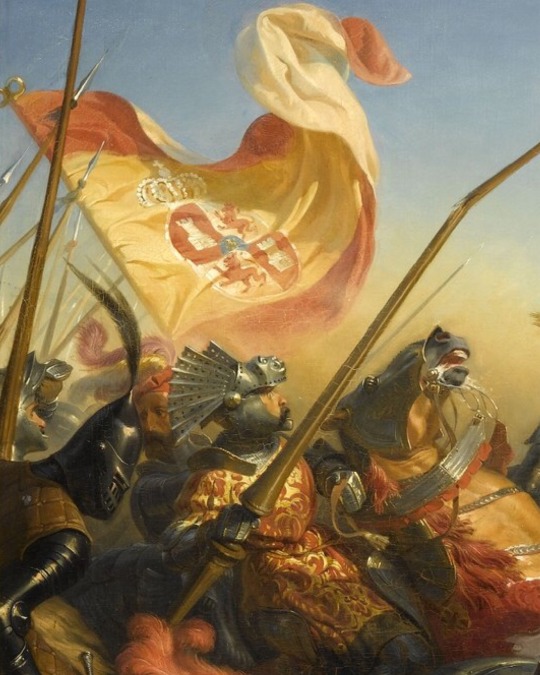


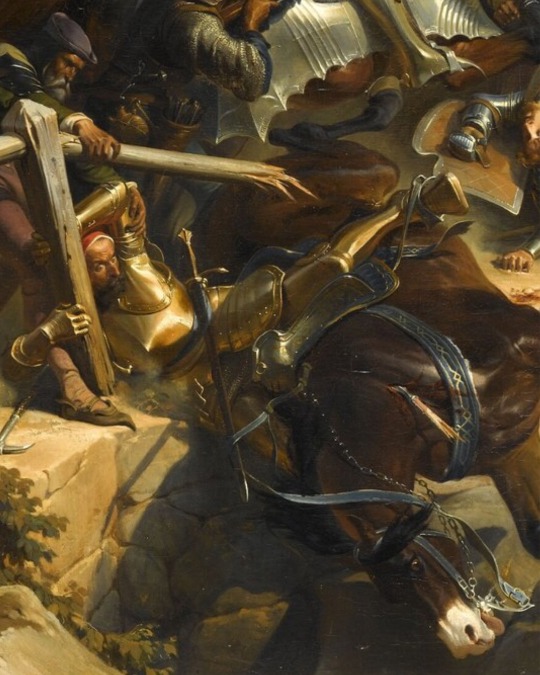
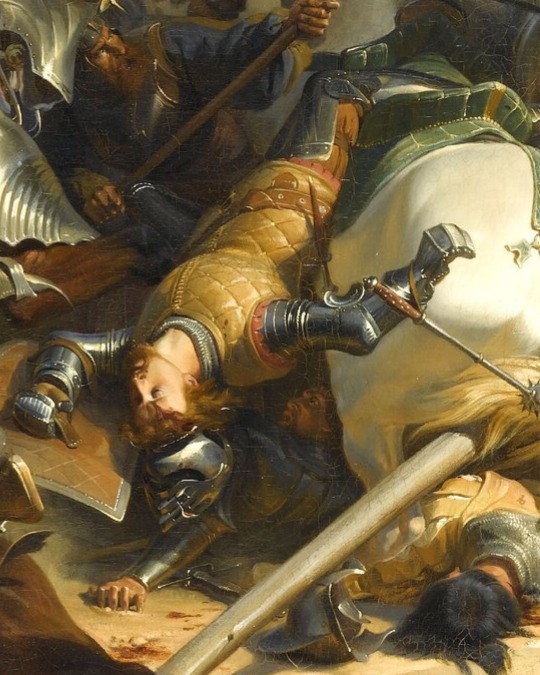

Henri-Félix-Emmanuel Philippoteaux.
Le Chevalier Bayard défendant l'entrée d'un pont sur le Carigliano.
Date 1839.
🏰 Сhâteaux de Versailles et de Trianon.
~*~
📝 Pierre Terrail, seigneur de Bayard, plus connu sous le nom de Bayard ou du chevalier Bayard, né en 1475 ou 14766 au château Bayard dans le royaume de France, et mort le 30 avril 1524 à Romagnano Sesia, ou Rovasenda, dans le Piémont, est un noble dauphinois qui s'illustra notamment comme chevalier durant les guerres d'Italie (XVe et XVIe siècles).
Sa vie est narrée par l'un de ses compagnons d'armes, Jacques de Mailles, dans la Très joyeuse et très plaisante histoire du gentil seigneur de Bayart, le bon chevalier sans peur et sans reproche. Il est à l'origine du personnage du Chevalier sans peur et sans reproche qui symbolise les valeurs de la chevalerie française de la fin du Moyen Âge. Une de ses devises est « Accipit ut det » qui signifie « Il reçoit pour donner ».
~*~
171 notes
·
View notes
Text

The Death of Chevalier Bayard by Benjamin West
This episode tells of Pierre Terrail, Chevalier de Bayard, who served three French Kings and was shot from an arquebus on 30 April 1524. The dying Chevalier is lying, propped up against a tree with his defeated adversaries coming to pay their respects and his mounted comrade apparently telling everyone to make less noise, which seems a strange instruction on a battle-field. The dying man was said to have recited his ‘Miserere’ (‘Lord have mercy on me’) holding his sword; in Wests’s painting the hilt acts as a perfect cross, the appropriate emblem for a Christian warrior.
#chevalier de bayard#bon chevalier#pierre terrail#knight#medieval#france#knights#middle ages#art#history#french#benjamin west#europe#italian wars#chevalier#chivalry#knighthood#christian#chivalric#warrior#armour
35 notes
·
View notes
Text
Lista di libri dedicati a furti e ladri
Sull’onda della visione del telefilm La casa di carta on #Netflix ho deciso di proporvi una lista di romanzi che parlino appunto di ladri e furti. Un argomento che ha sempre interessato molto la letteratura. Naturalmenet non è una lista esaustiva, i titoli sono così tanti, ma ho cercato di darvi più titoli in ogni nicchia del genere e tutti reperibili in italiano.
Partiamo dai classici naturalmente:

- L' eredità misteriosa. Rocambole. Vol. 1 (1857) di Pierre Alexis Ponson du Terrail
Primo volume del ciclo dedicato al ladro Rocambole
1812, mentre le truppe di Napoleone si ritirano dalla Russia, si compie una sanguinosa vendetta tra due ufficiali della Grande Armata francese. Molti anni dopo, a Parigi, gli eredi di quella faida danno vita a una lotta senza esclusione di colpi tra il Bene e il Male. Da una parte il conte Armand de Kergaz, che impiega le sue risorse a favore dei più deboli, dall'altra il fratellastro Andréa, alias sir Williams, vero e proprio genio del crimine, mentore del futuro protagonista: Rocambole. Sullo sfondo di una città affascinante quanto pericolosa, inizia così uno dei capisaldi del romanzo d'appendice, dove non mancano amori, passioni e cruenti delitti.
- Raffles: il ladro gentiluomo (1898) di Ernest William Hornung
Primo libro della serie sul ladro gentiluomo Raffles
È mezzanotte sull’Albany Street londinese. Harry “Bunny” Manders ha perso tutto al gioco. Negli ultimi tempi la sfortuna lo perseguita. Il suo lavoro come giornalista non rende e l’unica cosa sensata da fare sembra quella di introdursi nell’appartamento di uno dei creditori. A.J. Raffles è un suo vecchio compagno di scuola, forse a lui può confessare l’inutilità degli assegni che ha firmato, il suo conto in rosso. Raffles lo guarda con i suoi occhi azzurri taglienti, accende una Sullivan e prepara due whisky e soda. Ma Bunny non ha voglia di bere, Bunny ha una pistola nella tasca del suo cappotto e se la punta dritta sulla tempia. Intravedere una via d’uscita dalla situazione è quasi impossibile, eppure Raffles, carezzandosi il suo curato pizzetto, propone un piano. Forse un suo amico può aiutarli entrambi; ma quale amico si va a trovare nel cuore della notte, alla luce dei fiammiferi, in un appartamento abbandonato che guarda caso sta proprio sopra la famosa gioielleria dell’amico in questione?
- Arsenio Lupin (1905) di Maurice Leblanc
Anche questa è una serie di libri, ma Newton Compton ha raccolto tutti i vari racconti in un unico volume nel caso vi interessi intitolato Tutte le avventure di Arsenio Lupin
Arsenio Lupin è un raffinato ladro gentiluomo, amante delle donne, del gioco d'azzardo e dotato di uno spiccato sense of humor. Per questo personaggio pare che Maurice Leblanc si sia ispirato a Marius Jacob, anarchico francese e ladro inafferrabile.
- La primula rossa (1905) di Emma Orczy
Primo libro di un ciclo dedicato alla Primula Rossa
Parigi, anno di grazia 1792. Il Regime del Terrore semina il caos. I “maledetti aristos”, sventurati discendenti delle famiglie aristocratiche francesi, vengono mandati a morte dall'implacabile tribunale del popolo: ogni giorno le teste di uomini, donne e bambini cadono sotto la lama della ghigliottina. Ma in loro aiuto interviene un personaggio inafferrabile e misterioso, il quale, attraverso rocambolesche e ingegnose fughe, riesce a portare oltremanica i perseguitati del regime, nella libera Inghilterra. Dietro di sé non lascia tracce, se non il proprio marchio: un piccolo fiore scarlatto, che gli varrà il soprannome di Primula Rossa. Ma quale identità si cela dietro questo pseudonimo? Chi è l'audace salvatore, disposto a rischiare la propria vita in nome della nobile causa? L'incognita ossessiona l'astuto e crudele funzionario del governo francese Chauvelin e affascina l'alta società inglese: ma la soluzione del mistero si rivelerà tanto insospettabile quanto geniale. romance e romanzo d'avventura, il ciclo della "Primula Rossa" viene qui presentato in una nuova traduzione.
- Simon Templar, alias il Santo (1928) di Leslie Charteris
Serie di più di 50 romanzi
Simon Templar è un Robin Hood moderno, un giustiziere che agisce ai margini della legge e che, almeno nelle apparizioni iniziali, non disdegna l'omicidio a fini di giustizia. Di lui si sa poco: è probabilmente di umili origini, è dotato di uno spiccato sense of humour e ha una nutrita serie di identità fasulle. Il suo segno di riconoscimento è una stilizzata figura umana con un'aureola sui bigliettini che lascia a mo' di firma sul luogo delle sue imprese per lo scorno dei rappresentanti della legge, abitualmente beffati: l'ispettore Teal di Scotland Yard e l'ispettore John Fernack della polizia di New York.
- Il barone fa il poliziotto (The Baron), di John Creasey sotto pseudonimo Anthony Morton
Anche questa è una lunga serie di libri brevi
Protagonista delle storie è John Mannering, un antiquario inglese con negozi a Washington, Parigi e Londra; in realtà è un agente segreto ex ladro di gioielli che sta indagando su casi di spionaggio internazionale con l'aiuto del suo collaboratore David Marlowee.
- Il ladro che credeva di essere Bogart (1977) di Lawrence Block
Un ladro, una città, un mistero. Il ladro è Bernie Rodhenbarr, disincantato libraio con l'hobby del furto e una netta inclinazione a ficcare il naso in faccende pericolose. La città è New York, una categoria dello spirito più che una metropoli, con i suoi cinemini d'essai dove è ancora possibile scambiare la realtà per un sogno in bianco e nero. Il mistero è quello di un cadavere in cerca d'autore
Romanzi più Contemporanei:
- La grande rapina di Nizza di Ken Follett
Il libro è una ricostruzione delle vicende connesse con la grande rapina di Nizza, portata a termine ai danni della filiale nizzarda della banca Société Générale da una banda di malviventi capeggiati da Alberto Spaggiari. La "grande rapina" fu definita tale per l'ammontare del maltolto (circa cento milioni di franchi dell'epoca) e per le modalità, dal momento che i ladri penetrarono nel caveau della banca tramite una galleria scavata a partire da alcuni cunicoli fognari cittadini.
- Vuoto di luna di Michael Connelly
Cassie Black ha passato sei anni in prigione per un furto al casinò dove ha perso la vita il suo compagno. Durante la libertà vigilata progetta di riprendersi la figlia, in adozione, arraffare un sacco di soldi e scomparire nel nulla. Ma qualcuno le sta alle costole...
- Il principe dei ladri di Chuck Hogan
Claire Keesey, direttrice di filiale di un istituto di credito di Boston, viene presa in ostaggio durante una rapina. I banditi sono quattro: Doug, Jem, Gloansy e Dez. "Fanno banda" sin dai tempi della scuola, e oggi sono rapinatori affiatati, precisi, spregiudicati e inafferrabili. Sono cresciuti insieme a Charlestown, un quartiere di Boston dove "guadagnarsi il pane" equivale a svaligiare una banca. Ma Doug, il cervello della banda, non aveva messo in conto che, insieme con una montagna di quattrini, dal colpo in banca si sarebbe portato a casa anche un cuore ferito. Gli sono bastati pochi attimi per innamorarsi di Claire. Continua a pensarla, dopo la rapina: sa dove abita, la segue, fa in modo di incontrarla, di sedurla.
- La modista, un romanzo con guardia e ladri di Andrea Vitali
Nella notte hanno tentato un furto in comune, ma la guardia Firmato Bicicli non ha visto nulla. Invece, quando al gruppetto dei curiosi accorsi davanti al municipio s'avvicina Anna Montani, il maresciallo Accadi la vede, eccome: un vestito di cotonina leggera e lì sotto pienezze e avvallamenti da far venire l'acquolina in bocca. Da quel giorno Bicicli avrà un solo pensiero: acciuffare i ladri che l'hanno messo in ridicolo e che continuano a colpire indisturbati. Anche il maresciallo Accadi, da poco comandante della locale stazione dei carabinieri, da quel momento ha un'idea fissa. Ma intorno alla bella modista e al suo segreto ronzano altri mosconi: per primo Romeo Gargassa, che ha fatto i soldi con il mercato nero durante la guerra e ora continua i suoi loschi traffici; e anche il giovane Eugenio Pochezza, erede della benestante signora Eutrice nonché corrispondente locale della "Provincia"
- La falsaria di B.A. Shapiro
Sono circa tre anni che per il mondo dell’arte Claire Roth è un paria, una grande millantatrice. Dopo uno scandalo che la ha coinvolta sia sul piano personale che su quello professionale, Claire si è ridotta a lavorare per un’azienda che vende online «repliche perfette» di capolavori della storia dell’arte. Un giorno riceve l’inaspettata visita di Aiden Markel, il proprietario della famosa Markel G, una delle gallerie più in vista di Boston e New York. Markel irrompe nel suo loft con una singolare proposta: una mostra, nella sua galleria, delle opere originali di Claire in cambio della realizzazione di un falso da parte sua. Non una replica à la Roth, ma un vero e proprio falso da dipingere su una tela d’epoca. Una mostra tutta sua è qualcosa di irrinunciabile per Claire. Quando, però, Markel si ripresenta al loft con l’opera originale da falsificare, il cuore di Claire Roth sobbalza. Il quadro, uno dei grandi capolavori di Degas, fu staccato, infatti, in una notte di pioggia, dalle pareti dell’Isabella Stewart Gardner Museum e la tela strappata alla sua cornice da una coppia di ladri maldestri, impegnati nel più grande furto d’arte ancora irrisolto della storia.
Romanzi più leggeri e rosa:
Un sentimento pericolo di Suzanne Enoch
Samantha Jellicoe è una ladra e ne è orgogliosa. Amante delle cose belle, non esita a procurarsele rubando ai ricchi le loro opere d’arte. Tutto cambia, però, la notte in cui tenta un furto in una villa a Palm Beach: l’esplosione di una bomba uccide una guardia e lei finisce per salvare la vita del padrone di casa, il playboy miliardario Richard Addison. Samantha è una ladra, è vero, ma se qualcuno pensa di farla passare per un’assassina si sbaglia di grosso. E se Richard è abituato a essere assediato dalle donne, quella che ha trovato in casa sua non sembra affatto interessata a lui. Però è vivo solo grazie a lei, l’unica a potergli dare le risposte che cerca. Così, fra gli intrighi del mondo dorato di Palm Beach, la seducente Samantha e l’affascinante Richard seguiranno gli indizi per scoprire anche il mistero di ciò che li unisce.
Ladro lui, ladra lei di Dani Sinclair
Brenna ama l'avventura, ma deve ammettere che introdursi in casa d'altri per sottrarre un dipinto sia un tantino eccessivo. Eppure non ha scelta: la reputazione del nonno, famoso pittore, dipende da lei. Ma quando Brenna, invece di mettere le mani sulla preziosa tela, un sensualissimo nudo femminile, si trova tra le braccia del ladro più sexy che abbia mai visto, il suo stupore è alle stelle. In realtà Spencer Griffen è un onesto cittadino, costretto a dare la caccia al fantomatico quadro per... comune senso del pudore! Insieme...
Una ladra tra le lenzuola di KRISTIN GABRIEL
Michael Wolff è giovane, scapolo e carino. In più è miliardario. Perciò è normale che le donne lo cerchino e mirino al suo denaro. Quello che Michael proprio non si aspetta è di trovarne una addirittura che sta aprendo la sua cassaforte! Sarah Hewitt, questo il nome della presunta ladra, in realtà ha un ottimo motivo per avere... le mani nel sacco. Il difficile sarà convincere Michael delle sue buone ragioni. Così, quando lui le fa una proposta che non si può rifiutare...
Il ladro di cuori di KRISTIN GABRIEL
Maddie Griffin è decisa a dimostrare al padre che ha tutte le carte in regola per far parte dell'agenzia investigativa di famiglia. Così, quando sulle pagine di una rivista riconosce la foto del famigerato Bandito Casanova, alias Tanner Blackburn, decide che deve essere lei a consegnare il fuggiasco alla giustizia. In realtà Tanner non ha mai nemmeno preso una multa per eccesso di velocità, ma prima di riuscire a spiegarlo a Maddie... è già in manette!
Una pericolosa rubacuori di TORI CARRINGTON
Nicole Bennett, flessuosa e sensuale come un gatto, sa anche tirare fuori gli artigli e, poiché è una inafferrabile ladra di gioielli, questa dote le è molto utile. Spera che lo sarà ancora di più quando cercherà di rubare il cuore di Alex Cassevetis.
All’interno del Genere fantasy:
Sei di corvi di Leigh Bardugo
A Ketterdam, vivace centro di scambi commerciali internazionali, non c'è niente che non possa essere comprato e nessuno lo sa meglio di Kaz Brekker, cresciuto nei vicoli bui e dannati del Barile, la zona più malfamata della città, un ricettacolo di sporcizia, vizi e violenza. Kaz, detto anche Manisporche, è un ladro spietato, bugiardo e senza un grammo di coscienza che si muove con disinvoltura tra bische clandestine, traffici illeciti e bordelli, con indosso gli immancabili guanti di pelle nera e un bastone decorato con una testa di corvo. Uno che, nonostante la giovane età, tutti hanno imparato a temere e rispettare. Un giorno Brekker viene avvicinato da uno dei più ricchi e potenti mercanti della città e gli viene offerta una ricompensa esorbitante a patto che riesca a liberare lo scienziato Bo Yul-Bayur dalla leggendaria Corte di Ghiaccio, una fortezza considerata da tutti inespugnabile. Una missione impossibile che Kaz non è in grado di affrontare da solo. Assoldati i cinque compagni di avventura – un detenuto con sete di vendetta, un tiratore scelto col vizio del gioco, uno scappato di casa con un passato da privilegiato, una spia che tutti chiamano lo "Spettro", una ragazza dotata di poteri magici –, ladri e delinquenti con capacità fuori dal comune e così disperati da non tirarsi indietro nemmeno davanti alla possibilità concreta di non fare più ritorno a casa, Kaz è pronto a tentare l'ambizioso quanto azzardato colpo. Per riuscirci, però, lui e i suoi compagni dovranno imparare a lavorare in squadra e a fidarsi l'uno dell'altro, perché il loro potenziale può sì condurli a compiere grandi cose, ma anche provocare grossi danni...
Gli inganni di Locke Lamora di Scott Lynch
Piccolo di statura, deboluccio e un po' imbranato con la spada, Locke Lamora ha però un grande punto di forza: nessuno lo può battere quanto ad astuzia e abilità truffaldina. E benché sia vero che ruba ai ricchi nessun povero ha mai visto un soldo bucato dei suoi furti. Tutto ciò su cui mette le mani lo tiene per sé e per i Bastardi Galantuomini, la sua banda. A suo modo, Locke è il re di Camorr, una città che sembra nata dall'acqua, ornata di migliaia di ponti e di sontuosi palazzi barocchi e popolata da mercanti, soldati, accattoni e, ovviamente, ladri. In realtà, Camorr è il dominio di Capa Barsavi, perversa mente criminale, che da qualche tempo è impegnato in una lotta senza quartiere con il Re Grigio, altro personaggio decisamente poco raccomandabile. Impiccione per natura, Locke si ritrova suo malgrado in mezzo a questo scontro di titani e rischia di lasciarci le penne. Anche perché il suo misterioso passato nasconde un segreto che può mettere in pericolo l'intera nazione camorrana...
Ladri di spade di Micheal J. Sullivan
Royce Melborn, ladro matricolato, e il suo degno compare, il mercenario Hadrian Blackwater, si guadagnano comodamente da vivere portando a termine imprese rischiose per conto di nobili di dubbia moralità, finché non vengono ingaggiati per sgraffignare una spada leggendaria. Questa volta, però, si troveranno coinvolti nell'assassinio di un re e intrappolati in una trama oscura che va ben oltre l'assassinio di un sovrano. Riusciranno i nostri eroi - l'ambizioso furfante e lo spadaccino idealista - a dipanare un antico mistero che ha rovesciato re e distrutto potenti imperi? Inizia così la nostra storia, densa di avventure, tradimenti, duelli, magia e leggende.
Harold il ladro di Aleksej Pechov
Un'immensa armata si sta radunando: migliaia di giganti, ogre e altre creature stanno unendo le forze da tutte le Terre Desolate, unite, per la prima volta nella storia, sotto un solo vessillo nero. Entro la primavera, forse anche prima, colui che è conosciuto come il Senza Nome raggiungerà con il suo esercito le mura della grande città di Avendoom. A meno che Harold l'Ombra, uno dei ladri più abili al mondo, non trovi un modo di fermarlo. Un romanzo che porta ai vertici la epic fantasy, il primo di una trilogia che segue le imprese di Harold l'Ombra, leggendario ladro di Siala, alla ricerca di un corno magico in grado di riportare la pace nel suo regno. Compagni d'avventura nel suo viaggio saranno una principessa elfica, Miralissa, la sua scorta, dieci Cuori Selvaggi, i guerrieri più esperti e mortali del mondo... e il giullare di corte del re (che potrebbe essere molto più - o molto meno - di quanto sembra).
3 notes
·
View notes
Text
Il était une fois... Pierre Terrail de Bayard
Il était une fois... Pierre Terrail de Bayard, héros de Marignan, légende du Garigliano. Pour tous les amoureux des hauts faits héroïques ! :-)
Troisième épisode de la série “Il était une fois” ! (pour accéder aux autres, c’est par ici). Notre modèle du jour est moins connu par son nom, souvent résumé en “Bayard”, que par ses hauts faits et sa place dans l’Histoire des héros. Qui ne connait “le chevalier sans peur et sans reproche ?” Qui ne sait répondre, à la question : “Marignan ?”, le nombre 1515 ? Eh bien voilà, avec ces deux…
View On WordPress
#Bayard#Garigliano#héros#Marignan#Pierre Terrail#Pierre Terrail de Bayard#sans peur et sans reproche
0 notes
Photo

Pierre Terrail, seigneur de Bayard (1473 – 30 April 1524) was a French knight, generally known as the Chevalier de Bayard. Throughout the centuries since his death, he has been known as "the knight without fear and beyond reproach" (le chevalier sans peur et sans reproche). He himself preferred the name given him by his contemporaries for his gaiety and kindness, "le bon chevalier", or "the good knight". (source: Wikipedia)
1 note
·
View note
Note
What is your top ten historical figures? And why?
I don’t know if I have a top ten tbh because the circle of historical figures I have researched (I mean beyond reading a few articles, wikipedia or other general stuff) is very limited.
Elizabeth I is obviously my number one for many reasons that deserve an essay lol but in short: it’s her story - a survival story-, her capacity for reflection, including self-reflection, her sense of humor, her acute awareness of the world around her, her loyalty to her servants and friends, her inclination to seek compromise solutions, her fight to maintain her independence, the thing that she knew what it is like to suffer herself before she ascended to the throne, her being “always the same“ and flexible in the same time, her belief in the power of the Word and her way with words and other things I forgot to mention now and will probably remember later that draw me to her. She never bores me.
Philip II of Spain and Robert Dudley, 1st Earl of Leicester, follow closely behind because just as with Elizabeth I have read much about them and without going into details, I think they were better men then their respective Black legends have led many people to believe. Philip was another example of a conscientious thinker-sufferer type I love so much. And, of course, their connection with Elizabeth - albeit of different nature for each of them- fascinates me too.
Also I have a soft spot for Catherine Parr (the reasons why) and Henry IV of France. Henry was my childhood hero thanks to the novels by Alexandre Dumas, Heinrich Mann and Pierre Alexis Ponson du Terrail, and I respect him for restoring peace in France after the decades of religious civil wars that was a hella task, for his, let’s call it, open mindedness and affability, for an attempt to reach a compromise between Catholics and Huguenots to name few things. Oh, and I absolutely love this speech.
Then there go historical figures I’m interested to learn more about and hopefully someday I will (in no particular order): Jeanne d’Albret (the queen of Navarre and mother of Henry IV), Catherine de Medici, Henry III of France, Joanna I of Naples, Margaret Beaufort, Elizabeth Stuart (the Winter queen), Anne I of Britain, Isabella I of Castile, Mary I of England, Walter Ralegh etc.
13 notes
·
View notes
Text
Get to Know My Character - Astaroth - 1/5

I decided to try my hand at this meme by forsakenoathkeeper using Astaroth. I will release the answers in small batches of 10 questions each for your comfort and hopefully accompanying each batch with one picture as an allusion to one of the questions. The first is the default portrait one (mind you the following pictures might depict him in a more stylized way).
And without further ado, here comes the first batch!
(comments are a plus and please let me know of my mistakes concerning oc building)
01. What does your character’s name mean? Did you pick it for the symbolism, or did you just like the way it sounded?
- His first given name “Bayard” is an Old French word that refers mainly to the color of his hair (copper brown/auburn) and was also the name of a legendary magical bay horse, featured in medieval poems and tales; Though often depicted as a hero in the french versions of these poems, in England the term became a synonym for “a clownish, blind and foolish horse”. This name is also linked to the historical character Pierre Terrail, lord of Bayard (1473 – 30 April 1524), a.k.a Chevalier de Bayard, who was a French knight, said to be “without fear and beyond reproach”, also called by his contemporaries as “le bon chevalier” - “the good knight” because of his kindness and cheerfulness;
- His second given name “Philippe” is the french form of the greek “friend of horses”. The greek form was also his paternal grandfather’s name;
- His official name “Astaroth” is the same as his demon patrons’ chosen at birth. Astaroth is a Grand-Duke of Hell that mainly represents idleness, self-doubt and rationalized philosophies;
- That being said, a quick analysis of these names give away quite a few hints about what kind of character Astaroth is: a usually merry, rash vampire nobleman, who happens to be fond of horses, with a tendency for laziness and yet with his heart in the right place;
- Yes I do think all of these names sound cool, but as I went further on my research, I realized these names’ meaning which actually go way beyond my personal taste for them.
02. What is one of your character’s biggest insecurities? Are they able to hide it easily or can others easily exploit this weakness?
- “Insecurities? What are you talking about?” or so would he say. It’s true he was always taught to never show any weaknesses as a ruler objectively should, but in his case, this upbringing kinda backfired, making him lose some self-awareness. Even if he wears his heart in his sleeve sometimes, he rarely touches the subject of his weaknesses and fears, not even with the ones he trusts the most. His major weakness, apart from his pride, has to be the fear of becoming alone in his later life, so he has a tendency to get emotionally dependent of his loved ones to a fault;
- Someone who would know him really well would be able to exploit those weaknesses, though.
03. What would be their favorite physical trait about themselves?
- To be honest, you could name any part of his body and he’d say that would be the one. For one thing, he brags about being a lean, mean hunting machine, a lot. But he probably likes best his hair, waist and legs… don’t ask.
04. What are their favorite traits about their lover? (one psychological and one physical)
- One particular physical trait he loves about Ivan is how his lips turn red if he stands in the cold for long enough. He thinks that sight is beauty incarnate;
- Psychologically-wise, he loves Ivan’s own pride in being human and how conscious he is in the decision that he will NOT succumb to him and let himself be changed, no matter how much Astaroth tempts him. That sort of moral chastity drives him nuts (in both ways) even if it leaves him in the doghouse most of the time.
05. Are they sexually confident or more of the shy type?
- He is not shy at all and knows very well where he stands in terms of sexuality since an early age, especially because vampires have no real reason to be biased about those questions (unless they want to conform to the human ways a bit too much, but then again, their typical arrogance comes in and plays a big part in blinding them to the concept of homophobia).
06. Do they have any hobbies that their lover finds unusual, odd, or otherwise annoying?
- Indeed. One might think Ivan would have problems with his bloodhunting, but Astaroth is a vampire, right? It comes with the package. So, as sociopathic it may sound on Ivan’s part, it really doesn’t bother him anymore;
- However, due to Ivan’s personal experiences, he finds Astaroth’s love and willingness to work with horses to be unsavory to say the very least. It boggles his mind how Astaroth doesn’t mind of those smelly, noisy hayburners. They are not practical to keep at home as pets (like Astaroth likes to do), eat a lot, are a nightmare to keep clean, and according to Ivan “have the potential to destroy a small village, eat babies and so on.”
07. Is there a catchphrase or sound that they tend to make a lot (likely without being aware of it)?
- It’s not really a catchphrase but it’s kind of a trademark of his how creative and colorful he can get with the insults he addresses his servants.
08. What is, perhaps, their biggest flaw? Are they aware of this or oblivious to it?
- He is so vain it can be crippling sometimes. It has certainly brought him some troubles, and as a flaw, it’s still very easy to exploit. On occasion he seems to be aware of that, he just pretends not to when he does, but most of the time he is oblivious to it, for instance when he spends obscene amounts of money in clothing, shoes, perfumes, and what’s worse, oil portraits of himself by arguing he can’t see himself in the mirror all the time, so he goes around it that way.
09. Do they have a favorite season? What about a favorite holiday?
- His favorite time of the year is the end of Summer, all the way through Autumn, when the temperature starts to lower, therefore more comfortable for him, and nights get bigger, so it’s easier for him to go around and get on with his business;
- His favorite holiday is the 2nd of November (All Souls Day), when he gets a free pass to go see his mother and the 6th of January when he gets Ivan and his sister their Christmas presents, staying in Russia the rest of Winter and most of the springtime. He spends the end of Spring at home in France (the last two or three weeks) but he tends to go back to Russia for the Summer. Then he goes back to France in late September and only comes back to Russia in January.
- The New Year is always a favorite too.
10. Is your character more feminine or masculine?
- I’d say he’s somewhere in between. He may seem more feminine on the outside, but his way of thinking is distinctively masculine.
2 notes
·
View notes